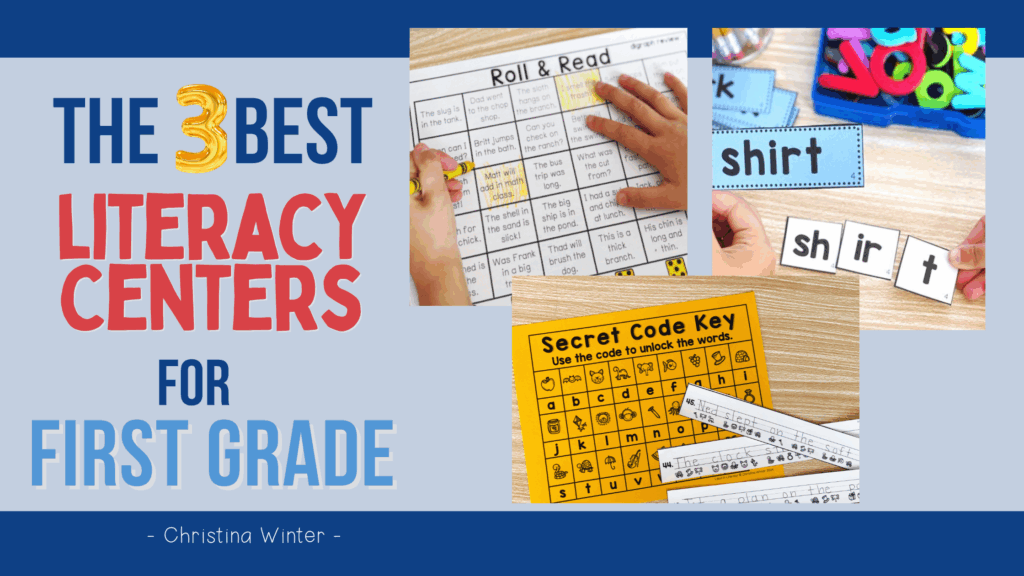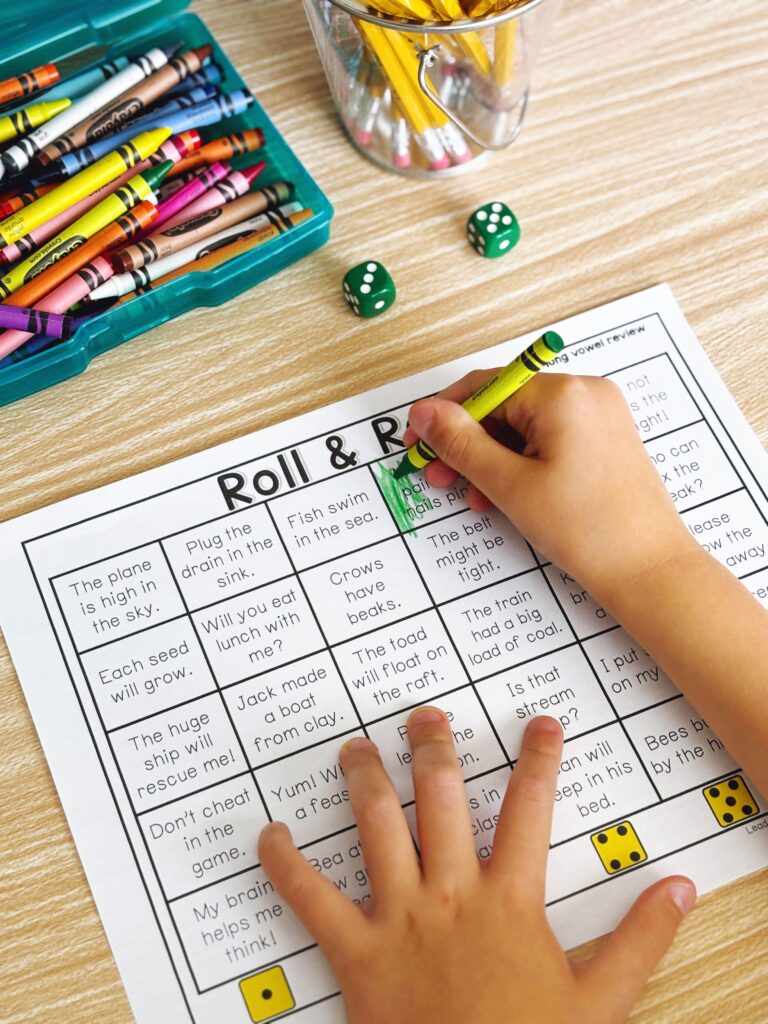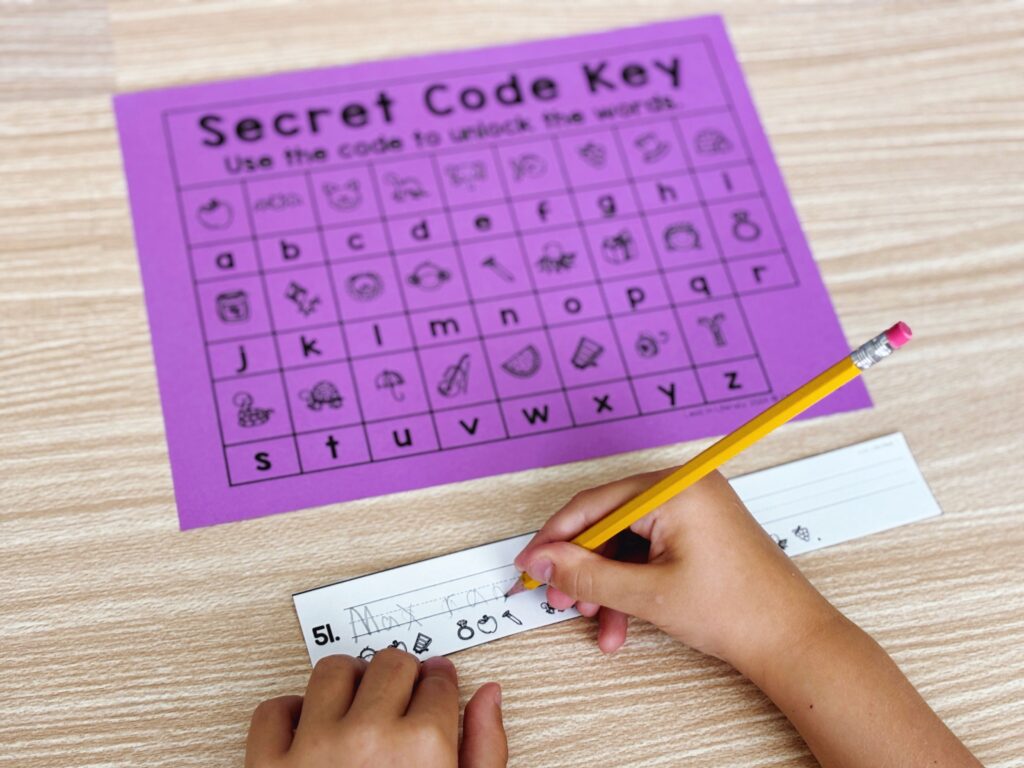In this post, you’ll discover…
- Tips for launching literacy centers and building student independence
- The 3 best literacy centers for first grade
When you think about implementing literacy centers in a first-grade classroom, what comes to mind? Chaos? Noise? A whole lot of interruptions?
Yes, centers can feel like a lot. They do require planning, prepping, and managing behavior. But with intentional instruction, solid routines, and the right materials, literacy centers can become the most productive part of your day in first grade.

In this post, I’m sharing my best tips for launching literacy centers in a first-grade classroom. I’ll also share three of my favorite first-grade literacy centers that are effective, consistent, and easy to prep. Most importantly, they give your students the meaningful, differentiated practice they need to master their phonics skills, while freeing you up to teach your targeted small groups.
Tips for Launching Centers and Building Independence in First Grade
1. Use the Gradual Release of Responsibility Model
Before students ever work independently in a center, they need explicit modeling and guided practice. First graders are capable, but they still need a high level of support when learning new routines.
You’ll want to move students through a clear progression of support:
- I do – The teacher models the task, thinking aloud and explicitly demonstrating what success looks like.
- We do – The class practices together, with the teacher guiding and providing feedback in real time.
- You do together – Students collaborate with a partner or small group, applying the skill with peer support.
- You do alone – Students work independently, demonstrating their understanding and mastery.

When you take time to intentionally model and gradually release responsibility, students gain the confidence they need to be successful and independent in centers
2. Introduce One Center at a Time
Don’t rush it. One of the biggest mistakes I see is introducing too many centers too quickly.
Instead, focus on just one activity at a time. Model it. Practice it. Reflect on it. Celebrate what went well. Once students show they can work in that center independently with success, introduce a second.
This approach not only builds independence but helps reduce your overwhelm, too.
3. Review Expectations Daily
Even after your centers are up and running, routines need to be reviewed consistently. Every day before center time, take just a few minutes to revisit expectations and preview what’s ahead.
When students know what’s expected and are reminded of the “why” behind their work, they’re more likely to stay focused. After each center rotation, take a minute to celebrate success and offer gentle redirection as needed.

The Best Literacy Centers for First Grade Students
1. Partner Word Building Center
Partner Word Building is a low-prep center that gets your students talking, thinking, and building words together and is always a classroom favorite!
Using this center, students work in pairs to match word cards with pictures, use printable letter tiles to build each word, and then record them on their own sheets. It’s hands-on, collaborative, and supports a wide range of phonics skills.

This single resource offers practice with CVC, blends and digraphs, CVCe, long vowels, r-controlled vowels, and diphthongs. You can target the exact skills your students are learning and practicing in small-group or whole-group instruction and use them all year long!
✅ Why it works: Reinforces decoding, spelling patterns, and phoneme-grapheme mapping.
✅ Prep level: Low (everything is printable and already organized by skill!)
✅ Tip: Use it as a literacy center, for morning work, or during your targeted small-group instruction.
Take a closer look at the Partner Word Building Yearlong Bundle here
2. Roll and Read Phonics Center
If you’re looking for a fun, low-prep way to boost decoding fluency, Roll and Read is an activity you’ll want in your first grade classroom.
In this partner-based game, students take turns rolling a die and reading sentences with target skills aloud. It’s simple, engaging, and gives students repeated practice with key phonics patterns. It builds their confidence and fluency in a low-pressure setting.

Because students are reading decodable sentences, they get to apply their phonics knowledge in context, not just in isolation. The structured, supportive format also makes it ideal for peer feedback and error correction—without overwhelming students.
✅ Why it works: Encourages decoding practice with short vowel CVC words in sentence form, reinforcing fluency and accuracy
✅ Prep level: None! Just print and go.
✅ Tip: Use this activity for morning work, as a literacy center, or as a task for early finishers!
This resource includes:
- 4 Student-friendly directions sheets
- 1 Student guide (routine) for error correction
- 35 Gameboards (8 CVC, 9 Blends & Digraphs, 9 Final e & Long Vowels, 9 R controlled & Diphthong/Other Vowels)
Grab Roll and Read for your first-grade classroom here!
3. Secret Code Phonics Center
Every classroom has those students who love a good puzzle. The Secret Code Phonics Center is a perfect way to harness that curiosity and put it to good use!
In this center, students use picture clues and phoneme isolation to “crack the code” and uncover mystery words that form a complete sentence. After they decode the sentence, they read it aloud for fluency practice. The secret-code element keeps them engaged, while the decoding and re-reading build foundational phonics and fluency skills.

✅ Why it works: In a single activity, students practice phoneme isolation, apply phonics skills to decode sentences, and reread for fluency.
✅ Prep level: Minimal. Just print and slide into a page protector or cut into strips.
✅ Tip: Use the provided secret code key for support and self-checking so students stay independent.
This resource includes:
- 350 secret code sentences organized by phonics skill (CVC, blends & digraphs, CVCe & long vowels, R-controlled, and diphthongs)
- Student-friendly direction pages
- Secret code key for scaffolding
- Answer keys for easy checking
It’s a playful, low-prep center that feels like a game, but delivers meaningful practice with decoding, phonemic awareness, and sentence reading. A true favorite among students and teachers!
Find the Secret Code Phonics Center here in the shop.
First grade is a big year for literacy growth. We must offer students plenty of opportunities to practice what they’ve been taught. I hope the information and resources I’ve shared here today will help make literacy centers a smooth-running, engaging, and meaningful part of your day.
Looking for center ideas for students working on a Kindergarten level? Check out this post where I share the best literacy centers for Kindergarten students!
Want Year-Round Literacy Centers?
When you join Leaders of Literacy, you get instant access to a full year’s worth of done-for-you, Science of Reading-aligned literacy centers for Kindergarten, 1st, AND 2nd grade.
These centers are:
✔️ Skill-based and naturally differentiated
✔️ Engaging and consistent for students
✔️ Aligned with our SoR-aligned scope and sequence
✔️ Designed to support your small group instruction, without extra prep
But that’s not all.
Inside the membership, you’ll also find:
- Explicit small group lesson plans for every phonics skill in our K-2 scope and sequence
- Printable student activities for small group instruction
- Bite-sized PD videos that help you teach with clarity and confidence
- Support from me and my team, so you never have to figure it out alone
You’ll have everything you need to run effective, efficient, and enjoyable centers and small groups.
CLICK HERE TO LEARN MORE ABOUT LEADERS OF LITERACY!

